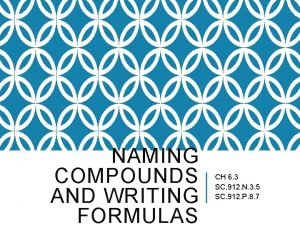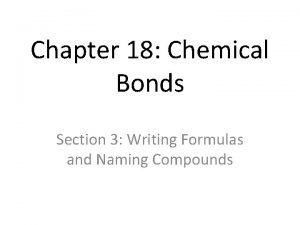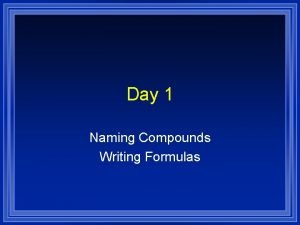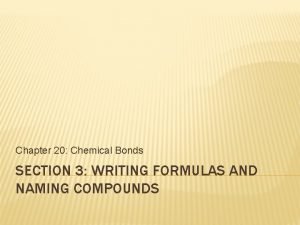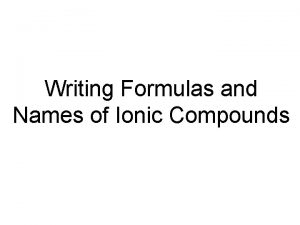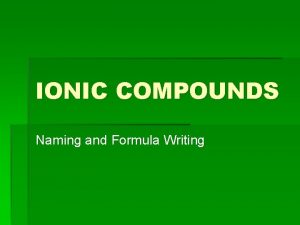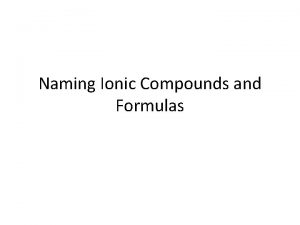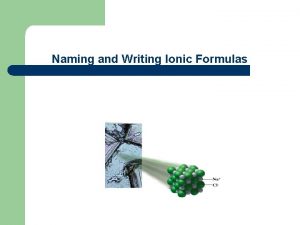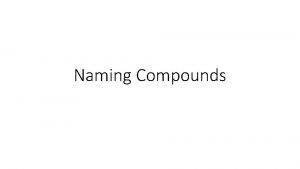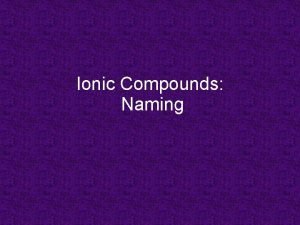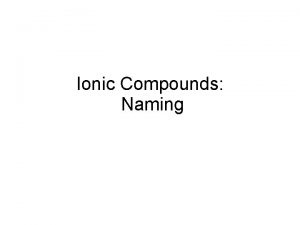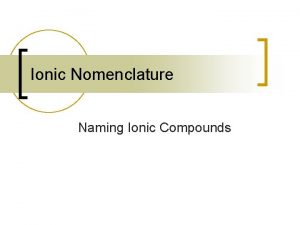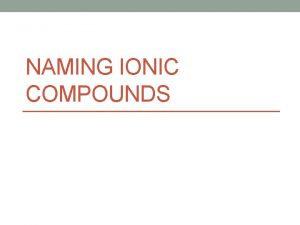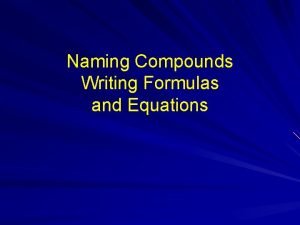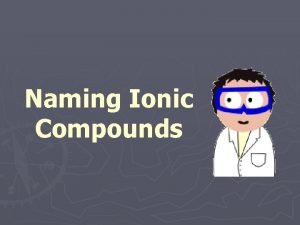Writing Ionic Formulas and Naming Ionic Compounds Writing












- Slides: 12

Writing Ionic Formulas and Naming Ionic Compounds

Writing Formulas Hint: Switchy-Switchy Example: Let’s make a compound using magnesium and chlorine • Steps • 1. Write each element with its charge (Periodic Table Columns can help with this) • 2. Switchy-Switchy Example Mg +2 Cl -1

Writing Formulas Hint: Switchy-Switchy Example: Let’s make a compound using magnesium and chlorine • Steps • 1. Write each element with its charge (Periodic Table Columns can help with this) • 2. Switchy-Switchy • 3. Reduce Example Mg 1 Cl 2

Naming Ionic Compounds • Example: Mg. Cl 2 • Steps • 1. Name the metal (cation) • 2. If the metal is a transition element, you must add a Roman Numeral in ( ) for the charge number (oxidation number) • 3. Name the non-metal (anion) changing ending to –ide Magnesium Chloride

Let’s look at Ti. O Titanium (II) Oxide Is titanium a transition element? Then we need a Roman Numeral But which one? We need to balance the charge The charge of O is _____, -2 so we must +2 be using a Ti with a charge of _____. Remember Switchy-Switchy then reduce

Anion Endings • If you see a name that ends in –ide, you are dealing with an element, unless peroxide, hydroxide, or cyanide • If you see a name that ends in -ate or –ite, you are dealing with a polyatomic ion (Page 178 or back of periodic table)

Polyatomic Hint • Nick the Camel ate Supper in Phoenix. • OH Nicky! • In the first saying, the first letter gives element, number of consonants gives number of oxygens, and number of vowels give charge. • Second is for Hydroxide (OH-) and ammonia (NH 4+)

How to read/name Polyatomic Ions • The first “rule” looks at the number of oxygens in an ion • Think of the -ate ion as being the "base" name • The per- prefix adds an oxygen. • -ite will reduce the oxygens by one. • Adding hypo- to the –ite version will reduce the number of oxygens by another 1 • In all situations, the charge is NOT affected.

For example, let’s look at the polyatomic ions that involve chlorine • Cl- chloride • Cl. O- hypochlorite • Cl. O 2 - chlorite • Cl. O 3 - chlorate • Cl. O 4 - perchlorate

How to read/name Polyatomic Ions • “Rule 2”: when the prefix bi- is added to a name, a hydrogen is added to the ion's formula and its charge is increased by +1 • An Example: • Carbonate – CO 32 • Bicarbonate – HCO 3 -

How to work with polyatomic ions • Think of them as a single ion • All the atoms stay together and if you need more than one, you have to use parenthesis. • For example, Magnesium Hydroxide +2 -1 Mg ( OH ) 2

Practice Cation Anion Name Formula Li+ Br- Lithium bromide Li. Br Na+ O-2 Sodium oxide Na 2 O Pb+2 F- Lead (II) Fluoride Pb. F 2 Mg+2 PO 4 -3 Cu+ CO 3 -2 Copper (I) Carbonate Cu 2 CO 3 SO 4 Ammonium sulfate (NH 4)2 SO 4 NH 4 + -2 Magnesium phosphate Mg 3(PO 4)2
 Monatomic ion
Monatomic ion Naming and writing formulas for molecular compounds
Naming and writing formulas for molecular compounds Section 3 writing formulas and naming compounds
Section 3 writing formulas and naming compounds Tetraiodine nonaoxide formula
Tetraiodine nonaoxide formula Section 3 writing formulas and naming compounds
Section 3 writing formulas and naming compounds Writing formulas from names
Writing formulas from names Covalent compound hi
Covalent compound hi Di vs bis
Di vs bis Venn diagram ionic and covalent bonds
Venn diagram ionic and covalent bonds Ni ionic charge
Ni ionic charge How do you name an ionic compound
How do you name an ionic compound Naming chemical compounds
Naming chemical compounds Ionic compounds review
Ionic compounds review

